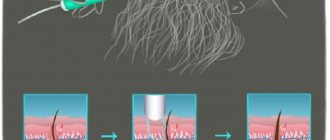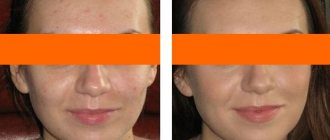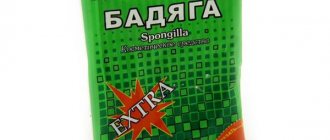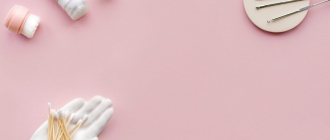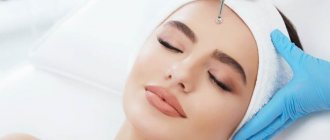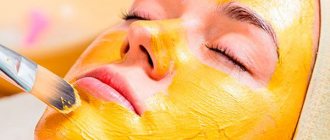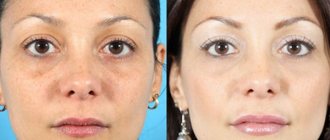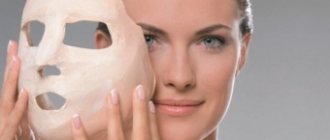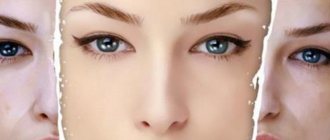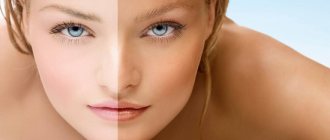Cosmetology clinics use a variety of tools for effective and safe cleansing of facial skin. But some devices from a cosmetologist’s arsenal can be used regularly at home.
One such tool is a Vidal loop with a needle. When using the loop, it is necessary to observe hygienic rules, otherwise there is a high risk of infectious skin lesions and the appearance of post-acne.
Design Features
Structurally, the Vidal loop is simply simple. The tool is a compact metal loop on a rod with a protruding handle-holder. Sometimes the device is made to look like a flat spoon with a hole inside. The Vidal loop is made of metal. It is best to choose options made from medical steel. The special alloy guarantees safe use of the tool.
What is a Vidal needle
A Vidal needle is a cosmetic device designed for mechanical cleaning of pores. The tool allows you to fix the following problems at home:
- acne;
- black dots;
- closed comedones;
- deep acne.
The Vidal needle was invented by the French bacteriologist Fernand Vidal around 1888. At this time, Vidal was conducting research at the Faculty of Pathological Anatomy, so initially the instrument was not considered cosmetological. Today, the Vidal needle is actively used for cleansing the skin; in particular, this device is indispensable for squeezing out blackheads and getting rid of pimples located quite deep in the skin.
The main advantage of the needle is its targeting, the ability to act specifically on the problem point without affecting nearby skin tissue. It is also worth noting the rapid healing of tiny wounds and the painlessness of the procedure.
The Vidal needle is a straight rod or a rod bent at an angle of 45 or 90° with a pointed end . Its tips and handle are made of medical steel.
Photo: Vidal's needle and its varieties
Many models of this tool have two working surfaces:
- the first is a needle itself, designed to remove acne that is located too deep, and to pierce the skin when getting rid of white pimples (milia);
- the second is the Vidal loop (or Uno spoon), used to eliminate comedones and blackheads.
Using a cosmetology needle, all areas of the face, as well as the ears and chin are cleaned. The tool is used only when the pimple is completely ripe, which is indicated by the appearance of a white head. In this case, the pus is completely removed, which minimizes the occurrence of damage to the skin.
Indications for use
The Widal loop is intended for mechanical skin cleansing procedures. The device is pressed in the area of pores or active inflammation. This helps remove defective contents out. This treatment allows you to deeply cleanse pores, remove blackheads, remove blackheads, comedones, and pimples. The loop is used to eliminate such defects on the face and body.
Attention! Compliance with the rules for using the tool allows you to eliminate the occurrence of post-acne problems after cleaning. This is important for preserving the aesthetics of appearance and accelerating healing.
How to choose?
The tool must be made of high-quality material. The loop, made of medical steel , is completely safe for use.
Therefore, before purchasing, it is necessary to clarify the composition of the Vidal loop. It is also important to consider that not only the loop should be made of medical steel, but also the handle.
The loop should be tightly attached to the rod. If it wobbles, use may become impossible or lead to unpleasant consequences.
Also, the loop should be smooth, without burrs. Otherwise, pressing can damage the skin.
Preparation for the procedure
It is important to keep the Vidal loop clean. Before and after use, the instrument must be disinfected. The device can be treated with standard alcohol.
It is recommended to wipe the skin with an antiseptic before using the loop. For oily skin, you can use alcohol and chemical-based lotions. For dry, sensitive skin, it is better to use a chlorhexidine solution as an antiseptic.
Before the cleaning procedure using a cosmetic loop, the surface to be treated is thoroughly cleaned of cosmetics and other contaminants. It is recommended to use mild detergents (without scrubbing particles).
After cleansing, it is advisable to steam the skin. It is acceptable to simply take a hot bath or shower without using additional products. The best option: a steam bath with a decoction of medicinal herbs. Suitable raw materials (chamomile flowers, calendula, sage leaves, coltsfoot, nettle, celandine) are poured with boiling water and left for 3-5 minutes. They bow their heads over the dishes with liquid and cover them with a towel. After 10 minutes, stop steaming and remove moisture from the skin with a clean napkin.
It is recommended to additionally wipe the surface with chlorhexidine. If you are prone to rosacea, steaming is not performed (you can limit yourself to taking a warm shower).
Reviews
According to user reviews, the Vidal needle is an effective device that can be used to solve cosmetic problems at home. This eliminates the need to visit salons, which is accompanied by time and material costs.
Despite the effectiveness and hygiene of the Vidal needle, it is recommended to consult a cosmetologist before deciding to use this tool.
Using the tool
They begin working with the instrument after preparing the skin and the device. You can learn how to use a stick correctly from numerous videos posted on the Internet. The loop is placed over the contaminated pore or pimple. The center of formation should be in the middle of the hole of the tool. The loop is held parallel to the surface of the skin.
After the instrument is positioned correctly, gently press the loop onto the surface. The contents of the defect come out. If you want to extract the contents of deep subcutaneous pimples, you will have to additionally use a Vidal needle.
The tip pierces the surface. It is recommended to find the mouth of the nearest pore and try to move the hole apart without causing unnecessary damage. Then perform standard loop manipulation.
After processing each element, the skin at the site of the impact is disinfected and the instrument is disinfected. Following hygiene rules, continue processing the following defects. After completing the cleansing of the integument, the surface is completely wiped with an antiseptic.
Advice. To achieve maximum anti-inflammatory, disinfecting, drying, soothing effect, apply a compress. You can use ready-made fabric-based masks or use gauze soaked in alcohol or chlorhexidine (selected according to your skin type).
Healing period
It is recommended to perform the procedure in the evening. After cleaning, you should not go outside or actively sweat. It is recommended to avoid contact of fabrics with water. It is advisable to relax and provide your body with a healthy night's sleep.
By morning, any possible redness will subside and the damage will heal. You can perform regular washing, which is recommended to be supplemented with the use of an antiseptic, lotion or decoction of medicinal herbs. The skin can be lubricated with your usual cream. It is recommended to avoid full makeup (foundation, powder, blush) for 1–2 days.
After the procedure, it is not recommended to engage in sports, visit the bathhouse or swimming pool for 1–2 days. After washing, use an antiseptic, lotion or herbal decoction. It is recommended to switch to medicinal cosmetics, which will be selected correctly by a cosmetologist.
Skin care after the procedure
Upon completion of the procedure, it is recommended to apply a compress . Make a mask out of a bandage. Make slits in the area of the eyes, lips, nose. Moisten with alcohol or vodka. Chlorhexidine can also be used. Apply the mask to your face and leave for 15-20 minutes.
This compress has an anti-inflammatory and disinfecting effect . In addition, it has a drying effect and helps relieve redness.
However, it is not recommended to use on very sensitive, dry skin or if there is flaking.
As an alternative, you can use a decoction of calendula or chamomile.
Infusions of medicinal herbs have a calming and anti-inflammatory effect , therefore promoting rapid healing.
However, you need to choose those plants to which you are not allergic.
Precautionary measures
Mechanical cleaning is contraindicated in cases of serious impairment of tissue regenerative abilities. The procedure is also not performed if:
- some dermatological problems (exacerbation of dermatitis, psoriasis, eczema);
- irritations on the surface (burn, allergy);
- excessive dryness of tissues, severe peeling of the integument;
- presence of rosacea;
- infectious diseases of the integument.
It is not recommended to carry out cleaning if you are feeling unwell. The condition will slow healing and may contribute to the development of complications. Among which are:
- slight redness of the surface;
- damage to tissues and capillaries;
- addition of infection.
Important! The likelihood of side effects increases if the rules for working with the loop and hygiene requirements are violated. Movements must be precise and careful.
What is the name of the facial cleansing spoon?
Manual or manual facial cleansing involves carrying out actions that many girls love to do on their own, although not at the proper level - targeted removal of pimples and blackheads. People call this simply “squeezing out pimples,” but if such a procedure is carried out unprofessionally, then there is a high risk of spreading inflammatory foci and worsening the situation. In a beauty salon, cleaning is carried out under conditions of strictly sterile instruments, the skin is properly prepared and processed afterwards, due to which an excellent cleansing effect is achieved.
A cosmetologist can clean with his fingers, but most often he uses a special device - a metal Uno spoon. The device is made of medical steel and is visually similar to a dental accessory. At the two ends of the long handle there are small “spoons”: one with a large hole in the middle (called a loop), and the second with several small holes (a sieve). The sieve attachment is designed to remove comedones, and the loop helps deal with large pimples. Today you can find such a tool not in one piece, but in the form of a handle with replaceable attachments that change during the cleaning process.
Opinion of cosmetologists
Doctors actively use professional cleaning tools. Many people see an effective result and praise the device. Some cosmetologists accept only modern technologies and refuse to use mechanical cleaning methods.
The cosmetologist recognizes the procedure as painful, but effective.
The cosmetologist recognizes the option as ideal for cleaning.
The cosmetologist calls the option an outdated method of cleaning.
